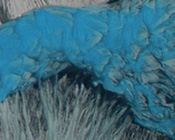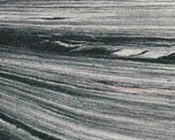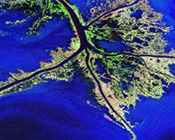Is it Feasible to Build New Land in the Mississippi River Delta?
 What if the Mississippi River levees were cut below New Orleans? What if much of the water and sediment were allowed to flow out and build new deltas? Could deltaic land loss be reversed and even restored? Using a conservative sediment supply rate and a range of rates of sea level rise and subsidence, a physically based model of deltaic river sedimentation [Kim et al., 2009] predicts that approximately 700 to 1200 square kilometers of new land (exposed surface and in-channel freshwater habitat) could be built over a century.
What if the Mississippi River levees were cut below New Orleans? What if much of the water and sediment were allowed to flow out and build new deltas? Could deltaic land loss be reversed and even restored? Using a conservative sediment supply rate and a range of rates of sea level rise and subsidence, a physically based model of deltaic river sedimentation [Kim et al., 2009] predicts that approximately 700 to 1200 square kilometers of new land (exposed surface and in-channel freshwater habitat) could be built over a century.
Read more: Nature Geoscience, News & Views: Kim 2012, EOS Feature article: Kim et al. 2009
Press release: NSF NEWS, AAAS ScienceNow, NewScientist Environment, UT Know
Movie: Land-building Model
Mass-balance control on the interaction of axial and transverse channel systems
 We present a geometric, sediment mass-balance model for the interaction of axial and transverse alluvial systems in a subsiding basin. By comparing the model result with a flume experiment that employed a simplified half-graben tectonic geometry with axial and transverse sediment sources, we quantify rates of axial-transverse erosional sediment mixing. In the experiment, the lateral migration rate of the axial-transverse boundaries due to the sediment mixing scales with sediment supplies delivered by transverse drainages, but neither with water (or sediment) discharge from the axial channel nor with tectonic tilting rate. Using an empirical lateral-erosion rate the model shows how sediment supply partitioning among the axial, hanging wall, and footwall drainages controls the width and the location of the axial-channel belt. Comparing the modeling results with field cases demonstrates that transverse sediment fluxes could slow the axial-channel migration or even reverse the movement against the tectonic forcing.
We present a geometric, sediment mass-balance model for the interaction of axial and transverse alluvial systems in a subsiding basin. By comparing the model result with a flume experiment that employed a simplified half-graben tectonic geometry with axial and transverse sediment sources, we quantify rates of axial-transverse erosional sediment mixing. In the experiment, the lateral migration rate of the axial-transverse boundaries due to the sediment mixing scales with sediment supplies delivered by transverse drainages, but neither with water (or sediment) discharge from the axial channel nor with tectonic tilting rate. Using an empirical lateral-erosion rate the model shows how sediment supply partitioning among the axial, hanging wall, and footwall drainages controls the width and the location of the axial-channel belt. Comparing the modeling results with field cases demonstrates that transverse sediment fluxes could slow the axial-channel migration or even reverse the movement against the tectonic forcing.
Read more: DOI: 10.1130/G31896.1
Movie: XES 2006
Steering of experimental channels by lateral basin tilting
 A major issue in tectonics and sedimentation is the role of cross-stream tectonic tilting in steering channels. The general idea is that channels will be attracted to lateral maxima in subsidence rate. A physical experiment performed in 1999 at the St. Anthony Falls Laboratory, however, was in conflict with the idea and showed that fluvial channels and resulting stratigraphy can be insensitive to even relatively strong lateral variation in subsidence. Here we present results from an experiment which uses a simplified relay-ramp geometry with laterally variable uplift and subsidence to test a hypothesis developed from the earlier experiment: Tectonic tilting steers channels only when the ratio of the time scales describing lateral channel mobility to tectonic deformation is sufficiently small.
A major issue in tectonics and sedimentation is the role of cross-stream tectonic tilting in steering channels. The general idea is that channels will be attracted to lateral maxima in subsidence rate. A physical experiment performed in 1999 at the St. Anthony Falls Laboratory, however, was in conflict with the idea and showed that fluvial channels and resulting stratigraphy can be insensitive to even relatively strong lateral variation in subsidence. Here we present results from an experiment which uses a simplified relay-ramp geometry with laterally variable uplift and subsidence to test a hypothesis developed from the earlier experiment: Tectonic tilting steers channels only when the ratio of the time scales describing lateral channel mobility to tectonic deformation is sufficiently small.
Read more: DOI: 10.1111/j.1365-2117.2009.00419.x
Movie: XES 2005 Experiment
Delta progradation driven by an advancing sediment source: Coupled theory and experiment describing the evolution of elongated deltas
 The research is motivated by the operation of the tailings pond of a mine in which a delta forms. The mine operators must frequently move the outfalls of their slurry pipelines downstream to avoid their burial under sediment as the delta aggrades. This downstream migration results in a characteristic delta configuration. Under the right conditions, as the tailings delta progrades downstream, it does not have time to fill all the available space in the lateral direction, thus leaving unfilled open water on either side. The result is the formation of an elongated delta. Here we use both experiments and numerical modeling to characterize the control of the feed point migration rate on the lateral extent of the prograding deltas. We use these results to obtain a partial explanation of natural elongated deltas.
The research is motivated by the operation of the tailings pond of a mine in which a delta forms. The mine operators must frequently move the outfalls of their slurry pipelines downstream to avoid their burial under sediment as the delta aggrades. This downstream migration results in a characteristic delta configuration. Under the right conditions, as the tailings delta progrades downstream, it does not have time to fill all the available space in the lateral direction, thus leaving unfilled open water on either side. The result is the formation of an elongated delta. Here we use both experiments and numerical modeling to characterize the control of the feed point migration rate on the lateral extent of the prograding deltas. We use these results to obtain a partial explanation of natural elongated deltas.
Read more: DOI: 10.1029/2008WR007382
Movie: Elongated Delta Experiment

